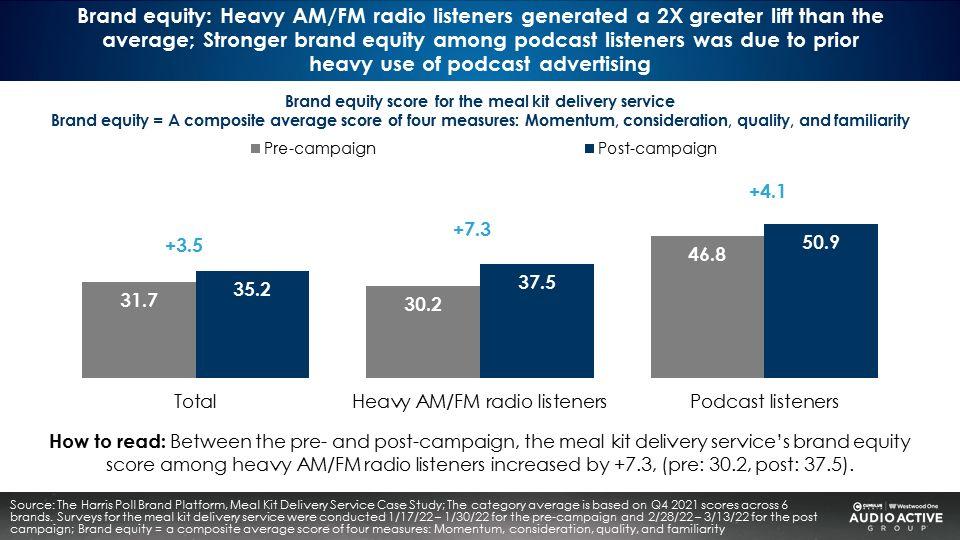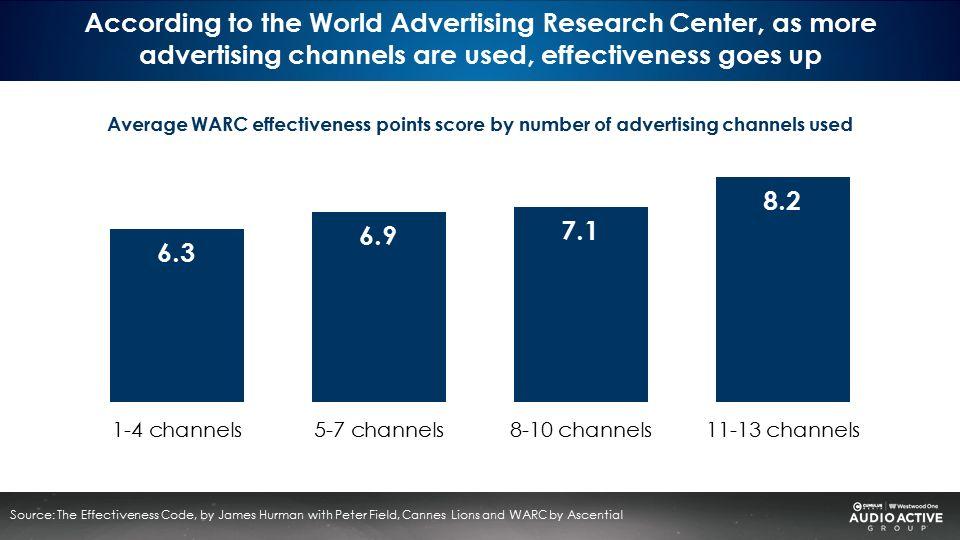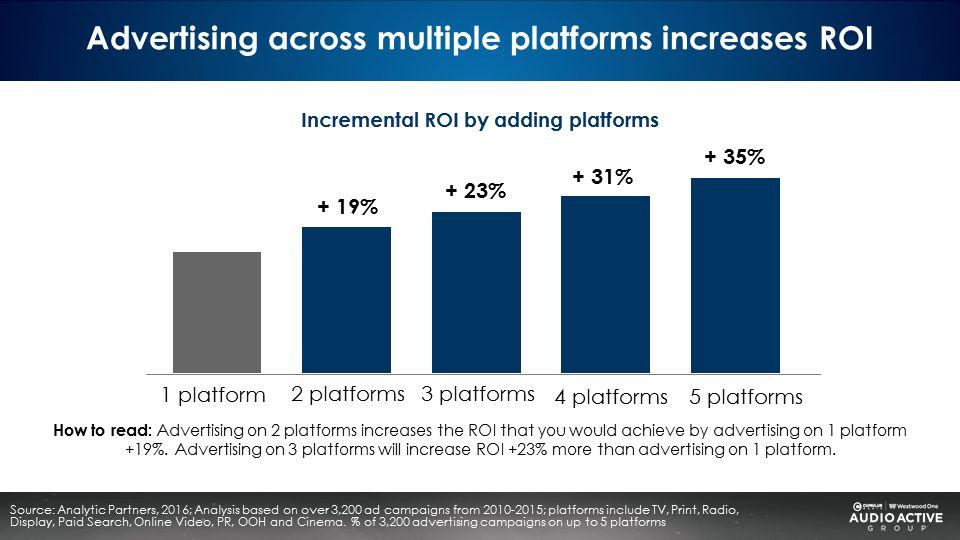Case Study: Meal Kit Delivery Service That Built Their Brand With Podcast Advertising Finds AM/FM Radio Can Expand Their Business
Click here to view a 9-minute video of the key findings.
Direct-to-consumer brands have successfully used podcast advertising to launch their businesses. The question is, have they saturated the podcast audience? Should they expand into AM/FM radio to grow reach and sales?
Testing AM/FM radio advertising for reach extension and sales growth
A meal kit delivery service had aggressively used podcast advertising to build their brand and business. They wanted to explore if AM/FM radio could be a platform to extend reach and generate growth.
The Cumulus Media | Westwood One Audio Active Group® commissioned The Harris Poll to utilize their brand tracker platform to understand the performance of the leading meal kit delivery service’s advertising.
The meal kit delivery service ran a national test campaign from January 31-February 27, 2022 on AM/FM radio. The Harris Poll Brand Tracker examined the performance of the pre-campaign (January 17-30, 2022), during the campaign, and the post-campaign (February 28-March 13, 2022).
The general population segment consisted of 3,148 respondents, the heavy AM/FM radio listener segment consisted of 678 respondents, and the podcast listener segment consisted of 1,032 respondents.
AM/FM radio worked: Brand equity growth among AM/FM radio listeners was 2X the general market
The Harris Poll Brand Tracker reports the campaign lifted brand equity (a composite of momentum, consideration, quality, and familiarity) between the pre- and the post-period by 3.5 points. Among heavy AM/FM radio listeners, brand equity grew 7.3 points, double the general market. The brand experienced 4.1 points of equity growth among podcast listeners.
The meal kit delivery service’s brand is fully developed among podcast listeners. Brand equity is much stronger among podcast listeners (50.9) versus the general market (35.2). This is a testament to the brand’s longstanding use of podcast advertising.
The meal kit delivery service’s brand equity is underdeveloped among AM/FM radio listeners. Prior the AM/FM radio campaign, the meal kit delivery service’s brand equity among AM/FM radio listeners (30.2) was actually lower than in the general market (31.7).

The AM/FM radio advertising test was a smashing success: Post-campaign, brand familiarity surged 9.6 points among heavy AM/FM radio listeners, double the general market growth
Building familiarity is a crucial aspect of driving sales. At a massive 68.4% familiarity before the campaign among podcast listeners, the familiarity growth among podcast listeners was only 2.6 points. The brand familiarity among podcast listeners is much stronger (71) than the general market (54).

AM/FM radio builds strong purchase intent: Among heavy AM/FM radio listeners, brand consideration grows 7.9 points, double the general market
Again, there are signs of podcast audience saturation. Brand consideration is much stronger among podcast listeners (56.9) versus the general market (39.7) and heavy AM/FM radio listeners (43.7).

Rome wasn’t built in a day – neither is product trial or usage
While the one-month AM/FM radio campaign caused awareness to surge, it is not enough of a sustained effort to cause similar levels of growth in brand trial and usage. Among heavy AM/FM radio listeners, brand trial grew +5% and brand usage grew +10%. The years of podcast advertising resulted in stunning lifts in brand trial (+21%) and brand usage (+51%) among podcast listeners.

Adding media platforms causes effectiveness and ROI to grow
There is significant evidence from major marketing effectiveness studies that shows as the number of media platforms utilized increases, ROI and sales effect improve. In the massive 2020 study “The Effectiveness Code,” conducted by James Hurman and Peter Field for the World Advertising Research Center (WARC), a key finding was as more advertising channels are utilized, effectiveness grows.

Advertising Research Foundation: Adding media platforms increases ROI
A major marketing effectiveness study conducted by the Advertising Research Foundation (the ARF) called “How Advertising Works” reveals return on advertising spend soars as the number of media are added.
What happens to advertiser return on investment when new media platforms are added? The more media types used, the higher the ROI.

Adding one new media platform to an existing medium causes ROI to grow +19%. Versus one platform, four media platforms have +31% greater ROI.
Growth opportunity: Expand beyond podcasts to AM/FM radio advertising as over half of meal kit users are reached by AM/FM radio but not podcasts
MRI Simmons examined media habits among meal kit users:
- 4% only listen to podcasts (no AM/FM radio)
- 30% listen both to podcasts and AM/FM radio
- 56% only listen to AM/FM radio (no podcasts)

The meal kit delivery service brand can double its addressable market with an expansion into AM/FM radio. While one-third of meal kit users listen to podcasts, 56% are reached by AM/FM radio and do not listen to podcasts. No wonder the AM/FM radio test generated such significant growth in brand equity, familiarity, and brand consideration.
Key takeaways:
- AM/FM radio worked for the meal kit delivery service. The test of AM/FM radio advertising was very successful. Between the pre- and post-campaigns, heavy AM/FM radio listeners generated immense brand equity growth, 2X greater than the average. Heavy AM/FM listeners, those with the greatest opportunity to hear the campaign, delivered the largest lifts for familiarity and consideration.
- Heavy historical use of podcast advertising resulted in significant awareness, consideration, and brand equity among the podcast audience for the meal kit delivery service brand. Due to sustained prior use of podcast advertising, podcast listeners far outperformed the average consumer across tested brand measures. Comparing podcast listeners to the general population, the meal kit delivery service had much stronger brand equity (+43%), consideration (+34%), and familiarity (+34%).
- The meal kit delivery service’s AM/FM radio and podcast campaign boosted purchase intention metrics. The AM/FM radio campaign drove positive movement throughout the purchase funnel. Since the pre-campaign period, there was growth in familiarity (+22%), trial (+5%), and usage (+10%) among heavy AM/FM radio listeners. Among podcast listeners, familiarity grew +4%, trial +21%, and usage +51%.
- Growth opportunity: Expand to consistent use of AM/FM radio advertising. As media effectiveness grows with the number of media channels utilized, meal kit delivery service brands have an opportunity to add reach and avoid podcast message saturation by using AM/FM radio. Among meal kit users, 56% only listen to AM/FM radio and don’t listen to podcasts. Expanding the media buy to AM/FM radio reaches the 56% of meal kit category users who aren’t exposed to podcast advertising.
Click here to view a 9-minute video of the key findings.
Pierre Bouvard is Chief Insights Officer of the Cumulus Media | Westwood One Audio Active Group®.
Contact the Insights team at CorpMarketing@westwoodone.com.